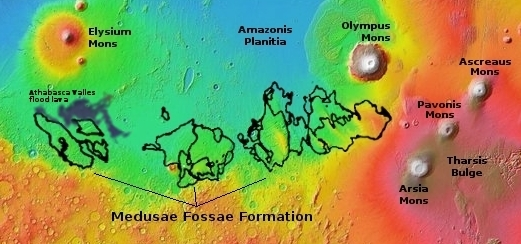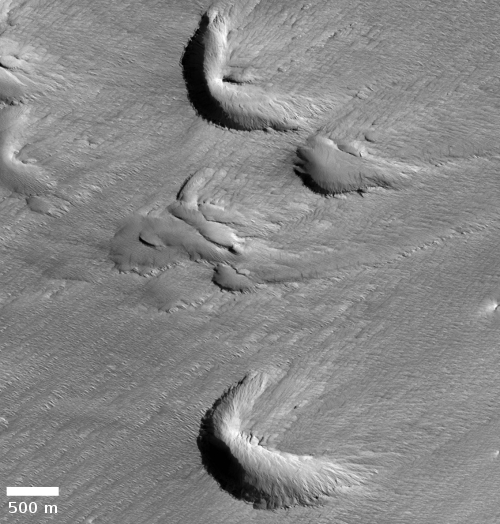Ice under Mars’ biggest volcanic ash field, at the equator?
According to new data obtained from the radar instruments on Mars Reconnaissance Orbiter (MRO) and Mars Express, scientists now think that the Medusae Fossae Formation, Mars’ biggest volcanic ash field and thought by some to be the source of most of the planet’s dust, might have an underground layer of ash that is also ice-rich. From their abstract:
The Medusae Fossae Formation (MFF) on Mars covers a vast area along the boundary between the rugged southern highlands and the smooth northern plains. While the MFF appears to be thick sediments or volcanic ash slowly eroding in the martian winds, how this material was emplaced remains mysterious. Most intriguing is evidence suggesting that some areas of the MFF may contain water ice. In this work we use sounding radar data from the SHARAD instrument on the Mars Reconnaissance Orbiter to probe up to 600 m below the surface and measure the electrical properties of the MFF material. The results suggest that the shallow parts of the MFF deposits are very porous and compress readily under their own weight. To match deeper probing by the Mars Advanced Radar for Subsurface and Ionosphere Sounding instrument on Mars Express requires a second layer of either vast porous deposits or ice‐rich material protected from sublimation by the dry sediments.
The MRO image above, originally posted here in November 2020, shows one example of the typical wind erosion found in the Medusae ash field. Apparently the ground-penetrating radar from orbit now suggests the possibility that there is an ash layer rich in ice, at depths beginning somewhere between 1,000 to 2,000 feet below the surface.

What makes this possibility important is that the Medusae ash field is located along the equator no more than 10 degrees latitude to the north and south. If a water-rich ash layer exists deep underground here this strongly suggests that an underground ice table likely exists everywhere on Mars, even in its most arid equatorial regions.
This conclusion has of course many uncertainties. First, the data could be explained not by an ice-rich layer but by a layer of porous layer made up of coarse sand. The scientists think this is unlikely because they do not see such sand at the margins of the Medusae ash field, where the lower layer might be exposed.
Second, the data is based on what the radar reveals, which includes many assumptions that could be found wrong when we finally dig down and look at actual samples.
The data also suggests that the dry upper layer of fine-grained ash could not have formed from the sublimation of its own ice. Instead, for there to be a lower layer of ice-rich material, the scientists theorize the following:
One possibility is that the Medusae Fossae Formation is a hybrid deposit, where parts of an extensive, thick, ice-rich unit was capped by a later “dry” component, perhaps through pyroclastic volcanism. The currently existing ice at depth would thus reflect the interplay of large-scale [relatively recent glacial] deposition with favorably timed volcanic eruptions that buried and preserved the ice through subsequent obliquity cycles.
If this explanation holds, it once again suggests that there is ample water on Mars. All you will need to do is dig down to find it, though at the equator it will be very deep.
On Christmas Eve 1968 three Americans became the first humans to visit another world. What they did to celebrate was unexpected and profound, and will be remembered throughout all human history. Genesis: the Story of Apollo 8, Robert Zimmerman's classic history of humanity's first journey to another world, tells that story, and it is now available as both an ebook and an audiobook, both with a foreword by Valerie Anders and a new introduction by Robert Zimmerman.
The print edition can be purchased at Amazon or from any other book seller. If you want an autographed copy the price is $60 for the hardback and $45 for the paperback, plus $8 shipping for each. Go here for purchasing details. The ebook is available everywhere for $5.99 (before discount) at amazon, or direct from my ebook publisher, ebookit. If you buy it from ebookit you don't support the big tech companies and the author gets a bigger cut much sooner.
The audiobook is also available at all these vendors, and is also free with a 30-day trial membership to Audible.
"Not simply about one mission, [Genesis] is also the history of America's quest for the moon... Zimmerman has done a masterful job of tying disparate events together into a solid account of one of America's greatest human triumphs."--San Antonio Express-News
According to new data obtained from the radar instruments on Mars Reconnaissance Orbiter (MRO) and Mars Express, scientists now think that the Medusae Fossae Formation, Mars’ biggest volcanic ash field and thought by some to be the source of most of the planet’s dust, might have an underground layer of ash that is also ice-rich. From their abstract:
The Medusae Fossae Formation (MFF) on Mars covers a vast area along the boundary between the rugged southern highlands and the smooth northern plains. While the MFF appears to be thick sediments or volcanic ash slowly eroding in the martian winds, how this material was emplaced remains mysterious. Most intriguing is evidence suggesting that some areas of the MFF may contain water ice. In this work we use sounding radar data from the SHARAD instrument on the Mars Reconnaissance Orbiter to probe up to 600 m below the surface and measure the electrical properties of the MFF material. The results suggest that the shallow parts of the MFF deposits are very porous and compress readily under their own weight. To match deeper probing by the Mars Advanced Radar for Subsurface and Ionosphere Sounding instrument on Mars Express requires a second layer of either vast porous deposits or ice‐rich material protected from sublimation by the dry sediments.
The MRO image above, originally posted here in November 2020, shows one example of the typical wind erosion found in the Medusae ash field. Apparently the ground-penetrating radar from orbit now suggests the possibility that there is an ash layer rich in ice, at depths beginning somewhere between 1,000 to 2,000 feet below the surface.

What makes this possibility important is that the Medusae ash field is located along the equator no more than 10 degrees latitude to the north and south. If a water-rich ash layer exists deep underground here this strongly suggests that an underground ice table likely exists everywhere on Mars, even in its most arid equatorial regions.
This conclusion has of course many uncertainties. First, the data could be explained not by an ice-rich layer but by a layer of porous layer made up of coarse sand. The scientists think this is unlikely because they do not see such sand at the margins of the Medusae ash field, where the lower layer might be exposed.
Second, the data is based on what the radar reveals, which includes many assumptions that could be found wrong when we finally dig down and look at actual samples.
The data also suggests that the dry upper layer of fine-grained ash could not have formed from the sublimation of its own ice. Instead, for there to be a lower layer of ice-rich material, the scientists theorize the following:
One possibility is that the Medusae Fossae Formation is a hybrid deposit, where parts of an extensive, thick, ice-rich unit was capped by a later “dry” component, perhaps through pyroclastic volcanism. The currently existing ice at depth would thus reflect the interplay of large-scale [relatively recent glacial] deposition with favorably timed volcanic eruptions that buried and preserved the ice through subsequent obliquity cycles.
If this explanation holds, it once again suggests that there is ample water on Mars. All you will need to do is dig down to find it, though at the equator it will be very deep.
On Christmas Eve 1968 three Americans became the first humans to visit another world. What they did to celebrate was unexpected and profound, and will be remembered throughout all human history. Genesis: the Story of Apollo 8, Robert Zimmerman's classic history of humanity's first journey to another world, tells that story, and it is now available as both an ebook and an audiobook, both with a foreword by Valerie Anders and a new introduction by Robert Zimmerman.
The print edition can be purchased at Amazon or from any other book seller. If you want an autographed copy the price is $60 for the hardback and $45 for the paperback, plus $8 shipping for each. Go here for purchasing details. The ebook is available everywhere for $5.99 (before discount) at amazon, or direct from my ebook publisher, ebookit. If you buy it from ebookit you don't support the big tech companies and the author gets a bigger cut much sooner.
The audiobook is also available at all these vendors, and is also free with a 30-day trial membership to Audible.
"Not simply about one mission, [Genesis] is also the history of America's quest for the moon... Zimmerman has done a masterful job of tying disparate events together into a solid account of one of America's greatest human triumphs."--San Antonio Express-News



obliquity cycles
Isn’t this just a Martian year? It’s tilted, like Earth, so its “obliquity” changing is a result of its position in its orbit, which “cycles” once per year. Or are they talking about longer-term precession wobbles? Thanks.
mrsizer: Obliquity refers to the rotational tilt of a planet’s pole. The Earth is tilted 23 degrees, which produces our annual seasons. Mars is presently tilted 25 degrees.
Mars’ obliquity varies much more wildly than Earths, ranging from 11 degrees to as much as 60 degrees, with the swings taking place over many hundreds of thousands of years. It is these changes that form the cycles.
See this post on Behind the Black for a more detailed explanation: The Icy Surface of Mars.
Wondering if Mars may approach ‘ice planet’ status. There seems to be a lot of it (or evidence thereof).
Blair K Ivey: I have written and said this now multiple times. Mars is not a desert like the Sahara, but a desert like Antarctica.